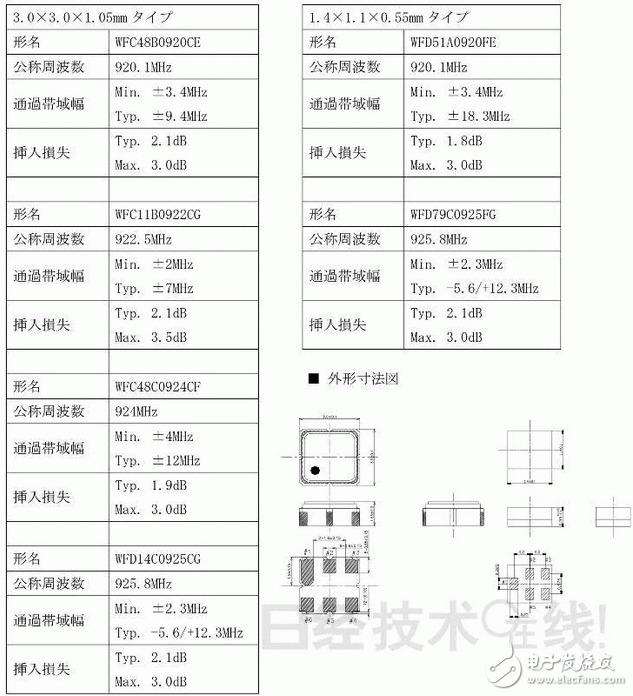Surface acoustic wave (SAW) technology is a rapidly evolving field that emerged in the late 1960s. It combines principles from acoustics and electronics, making it a highly interdisciplinary area of research and development. Over the years, SAW technology has advanced significantly, expanding its applications from military radar systems to a wide range of commercial uses, particularly in radio communication.
The rapid growth of mobile communication has played a key role in driving the development of SAW technology. As mobile networks evolved, so did the need for high-performance components that could handle increasing data demands. This demand led to the widespread use of surface acoustic wave filters (SAW filters), which are essential in modern communication systems.
A SAW filter is a passive device that utilizes the piezoelectric properties of materials like quartz, lithium niobate, or piezoelectric ceramics. These filters work by converting electrical signals into mechanical waves on the surface of the material and then back into electrical signals. This process allows for precise filtering of specific frequency ranges, making SAW filters ideal for applications requiring high selectivity and stability.

SAW filters are widely used in various electronic devices such as color televisions, mobile phones, GPS systems, satellite communications, and cable television. Their ability to suppress interference and improve signal clarity makes them indispensable in modern communication infrastructure.
Key parameters of SAW filters include:
- **Package**: Typically available in LCCC (lead-free ceramic chip carrier) form, with the smallest size being 2.5 x 2 mm and weighing around 22 mg.
- **Center Frequency**: The average of two cutoff frequencies at a specified insertion loss level, usually -3 dB.
- **Passband Width (Bandwidth)**: The frequency range between two cutoff points at a given insertion loss level.
- **Passband Ripple**: The variation in loss within the passband, defined as the difference between the highest peak and lowest valley.
- **Stopband Rejection**: The maximum level of unwanted signals in the stopband.
- **Rectangular Coefficient**: The ratio of bandwidths at different loss levels, often measured between 40 dB and 3 dB.
- **Group Delay Fluctuation**: The maximum difference in group delay across the passband.
- **Insertion Loss**: The amount of signal loss when the filter is inserted into the circuit. Modern SAW filters have achieved very low insertion loss, typically between 1 and 4 dB, which is crucial for power-efficient communication systems.
The operating frequency of a SAW filter depends on the width of the interdigital transducer (IDT) electrodes. Narrower electrodes allow for higher frequencies. For example, SAW filters operating at 2–3 GHz can be manufactured using semiconductor processes with feature sizes of 0.35–0.42 μm.

**SAW filter parameter table of a Japanese 920MHz band**
Applications of SAW Filters
SAW filters are used to suppress unwanted signals, such as harmonics, image frequencies, and parasitic noise, ensuring clean and stable signal transmission. They offer excellent amplitude and phase frequency characteristics, which are difficult to achieve with other types of filters.
In recent years, SAW filters have become even smaller, with some models weighing less than 0.2 grams. Advances in crystal materials and microfabrication techniques have pushed the upper frequency limit of SAW devices up to 2.5–3 GHz, further expanding their use in anti-EMI (electromagnetic interference) applications.
In CATV systems, SAW filters enable adjacent-channel transmission with a steep transition band, significantly improving spectrum efficiency. Without SAW filters, TV receivers would not operate as reliably or stably.
Initially, SAW filters were mainly used in consumer electronics like TVs. However, with the rise of the telecommunications industry in the 1980s, their market expanded rapidly. Today, over 600 million SAW filters are produced annually worldwide, with more than 430 million being small RF SAW filters for mobile communication.
Mobile communication systems require filters that can handle frequencies between 800 MHz and 2 GHz, with bandwidths of 17–30 MHz. These filters must have low insertion loss, high stopband rejection, and good performance at high power levels, all while being compact and cost-effective.
Due to their superior performance in terms of frequency range, size, and cost, SAW filters have become the preferred choice in mobile communication systems, surpassing alternatives like piezoceramic and monolithic crystal filters. In wireless paging systems, for instance, SAW filters are essential for processing received RF signals before amplification, directly affecting the sensitivity and accuracy of the received signal.
With the growing demand for high-speed internet access, the need for efficient data transmission has increased. While traditional internet connections suffer from limited bandwidth, CATV networks offer much greater capacity. To take full advantage of this, broadband multimedia broadcasting systems are being developed, and SAW filters play a critical role in managing adjacent channel interference.
As a result, the market for SAW filters continues to grow, driven by the demand for high-performance, compact, and cost-effective components in a wide range of applications. The future of SAW technology looks promising, with ongoing innovations set to expand its use even further.
Withstand high voltage up to 750V (IEC/EN standard)
UL 94V-2 or UL 94V-0 flame retardant housing
Anti-falling screws
Optional wire protection
1~12 poles, dividable as requested
Maximum wiring capacity of 10 mm2
10 amp Terminal Blocks,high quality terminal connectors,10 mm² terminal blocks,BELEKS T10 series connector strips
Jiangmen Krealux Electrical Appliances Co.,Ltd. , https://www.krealux-online.com